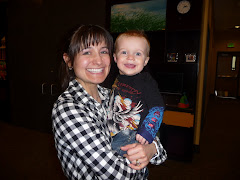It actually turned out better than I was expecting, and really, it was easier than making my normal bread. No kneading or shaping into a loaf, just dump in a pan like cake batter. Now I will warn you, this bread is really good for the first few hours out of the oven, but after that it gets very crumbly. I sliced it and put it in the freezer, hoping that would help, but no. Still, this bread tastes pretty good, and Sam eats it. I just have to have a vacuum out during meals.
(the Gluten-Free Goddess uses a bread machine, which I don't have. So if you have a bread machine, follow the first instructions; if not, scroll down and she tells you what to do for the oven version.)
Delicious Gluten-Free Bread Recipe
Most gluten-free bread recipes rely on eggs for texture and rise. Not this one. This gluten-free bread is tender, crusty, vegan, dairy-free, rice-free, and egg-free. I baked it in my Breadman bread machine.
1 cup sorghum flour
1 cup potato starch
1/2 cup millet flour (I used quinoa flour b/c I couldn't find millet flour)
2 teaspoons xanthan gum
1/ 1/4 teaspoons fine sea salt
1 tablespoon rapid dry yeat
You'll need sesame seeds for the top; set aside for later. Or omit.
Pour the liquid ingredients into the bread machine pan:
1 1/4 to 1 1/3 cup warm water (at 110 to 115 degrees F)
3 tablespoons extra virgin olive oil
1 tablespoon honey- or raw agave nectar to keep it vegan
1/2 teaspoon mild rice or white wine cider vinegar (or lemon juice)
1 tablespoon Ener-G Egg Replacer whisked with 4 tablespoons warm water till frothy
Gently pour the mixed dry ingredients on top of the liquid.
Set your bread machine program for 1.5 loaf medium crust. I used the gluten-free cycle on the Breadman; if you don't have a gluten-free cycle, I believe a rapid rise cycle will also work.
Check the dough after a few minutes of kneading- it should be closer to a muffin batter than bread dough, soft but not too wet. Adjust dry to wet ratio with a tablespoon of flour or warm liquid, as needed. Humidity influences the dough. As does temperature (your bread will rise higher on a hot day).
If you like a crusty loaf, remove the bread from the pan and place it in the oven at 350 degrees F for an additional 10 minutes- keep an eye on it and don't let it get too brown. It should be a light golden color.
Cool the loaf before slicing for best results.
Enjoy fresh from the oven- the first day (as with most gluten-free baked goods) has the best texture and taste.
Store the leftover bread as slices, wrapped in a paper towel and bagged in freezer bags; freeze. Thaw and toast or grill for best results.
Karina's Notes:
This yummy bread was not only the most successful egg-free yeasted bread to date- the taste, texture and tenderness make it one of my all-time top faves in gluten-free bread land. It didn't crumble. And it didn't taste ricey (well, duh...there's no rice!). The combination of sorghum and millet with potato starch imparts a springy bread texture that reminded us both of our favorite ciabatta bread recipe from our pre-gluten-free days.
Karina's Baking Tips for Fabulous Gluten-Free Bread
Have all the dry ingredients at room temperature.
Water should be 110 to 115 degrees F (too cool and the yeast won't rise; too hot and the yeast will die).
Yeast should be fresh- check the expiration date.
After a minute or two of mixing, open the machine and scrape down the sides of the pan with a soft spatula to help incorporate the bits of flour on the edges; I had to do this twice.
Immediately after the mixing/kneading cycle was finished I reached in and removed the paddle; then smoothed and pressed the dough and with wet fingers to even out the shape. It's not necessary to do this; I just prefer removing the paddle from the loaf ahead of time.
When the dough was resting I sprinkled a generous tablespoon of sesame seeds all over the top.
When the machine beeped "done". I immediately removed the pan from the hot machine, and within a minute released the bread from the pan (if you don't do this, it steams and gets a bit soggy) and placed it on a wire rack to do the thump test. It should sound hollow when tapped. And the loaf should feel firm (not squishy).
I thought the sides were a tad soft so I placed the naked loaf directly into the oven- on the center rack- and turned on the temp to 350 degrees. I baked it for another 12 to 15 minutes, keeping an eye on it. When I tapped the bread it sounded hollow. The crust was crusty. Done.
Cool the loaf on a wire rack. Slice when cooled with a sharp serrated knife. (If you don't wait for the loaf to cool the bread will not slice evenly.)
I am thinking this bread would make fabulous burger buns and pizza crust.
A note regarding altitude. At high altitude- you may only need one egg's worth of egg replacer. Experiment.
Readers sometimes ask if they can lessen either the oil or the sweetener in a recipe- in this case, I'd suggest, no. What really makes this bread tender and not crumbly is the give it gets from the honey and oil. When you don't use eggs or butter, you need to boost the stickiness factor- and flavor. That's why I use good tasting olive oil and honey (agave would work).
Yes, you could use real eggs in this recipe- I don't see why not. Beat two large organic free-range eggs.
If you find the center sinking, the dough may be too wet. Use less liquid- start with a tablespoon or two less liquid. If you use milk or non-dairy milk instead of water this could produce a denser loaf as well.
If the bread is gummy in the center use less honey or agave; both are humectant. If you use flax seed gel as an egg replacer, this can also create a gummy dough.
If you don't have a bread machine:
Follow the instructions for whisking together the dry ingredients.
Proof the yeast in the warm water (110 to 115 degrees F) and a teaspoon of the honey/agave (add the yeast to the water and honey stir; allow it to get poofy).
Add the proofed yeast to the dry ingredients; add the olive oil, remaining honey/agave, cider vinegar and mixed egg replacer (or egg); beat until a smooth batter forms. I use the word batter because gluten-free bread dough is more like muffin batter than wheat based bread dough.
Scrape the dough into a 1.5 pound loaf pan (or 7 to 8-inch round cake pan for ciabatta style) and smooth evenly (I use wet fingers). Top with sesame seeds. Loosely cover the pan and allow the dough to rise for 20 minutes in a warm spot. (I forgot to let it rise, and it still rose in the over.)
Preheat your oven to 350 degrees F. When the oven comes to temperature bake the bread until it sounds hollow when thumped. This might be anywhere from 35 to 45 minutes, and even up to 60 minutes if you're at higher altitude. Lower style round pan loaves will bake at 30 to 40 minutes, usually.
If you like a crusty loaf, remove the bread from the pan and return it naked to the oven at 350 degrees F for an additional 10 minutes- keep an eye on it and don't let it get too brown. It should be a light golden color.
Cool on a wire rack.

.jpg)
No comments:
Post a Comment